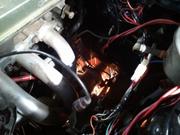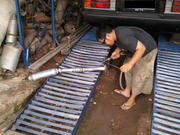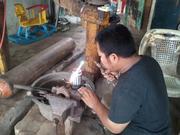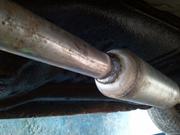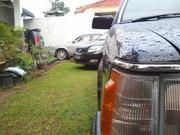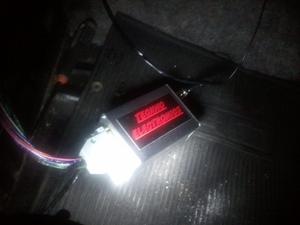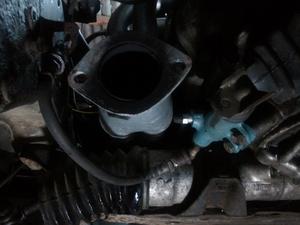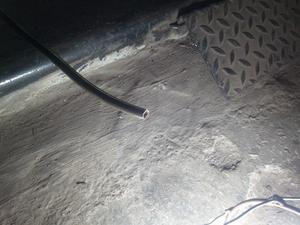Don't bother reading this post. This is just me writing down stuff i know so that i don't have to memorize them for future reference. Of course, you're welcome to read if you wish to know more on 4A-GE cooling system.
Found below diagram on Bill Sherwood's web. Bill's diagram is simpler and monochromatic so I decided to sharpen up my Photoshop skills and put fun colors and letters so that kindergartens are happy, grownups learn more and the world is a better place. I know it's overkill to use PS for this but shut up and read. Click here for bigger resolution of diagram above.
The coolant flow is such:
When thermostat is closed, water is pushed by the water pump into the engine block through "IN" port. It then circulates following the orange arrows inside the engine block, goes up to the cylinder head and exits through OUT1 and OUT2 port. From OUT1, water passes the thermostat and back to the pump following blue arrows to repeat the cycle while from OUT2 it goes basically the same only the water is also diverted to the heater and throttle body before arriving back to the pump.
If the thermostat is open after exposed to enough heat from the water coming out of OUT1 and OUT2, the flow is same only now water also goes in and out of the radiator (green arrows) so that heat can be reduced.
That diagram above obviously shows a 16v RWD 4A-GE (bigport?) seeing it has fan attached to the pump and the thermostat is integrated to the water pump housing. FWD 4A-GEs like smallports has its thermostat separated from the pump and housed inside what's commonly known as 'remote thermostat housing' looking similar to these, pic taken from this awesome guide. So, what are we learning from the diagram? Here's some:
First, cylinder 4, being furthest from the water pump, gets preheated water since coolant passes the other cylinders first before reaching it. This is why it's more common that engine gasket close to cylinder 4 fails first than the other cylinders.
Second, since there are two output ports for coolant from the cylinder head, you can block the water flow from OUT2 and still have the water flowing. However, this is not recommended because water around cylinder 4 needs to travel back to cylinder 1 before finally coming out the head. This way, heat will build up quicker around the back causing higher risk of overheating.
Third, you can bypass the heater rendering it useless or you can keep the heater function and if the engine is going to overheat, turning the heater on will also help cool the engine. It's only fair that you suffer what your engine is suffering.
Fourth, the thermostat needs to stay exposed to heated water or it'll always block water coming in from the radiator. To achieve this, water coming out of either OUT1 or OUT2 needs to always "tickle" the thermostat. This shouldn't be a problem if you have the RWD waterpump as it warrants this requirement by having the thermostat integrated to the water pump. If using a remote thermostat housing, however, you need to ensure that at least either OUT 1 or OUT 2 goes through the remote housing first before coming back to the pump. This is a mistake done by my workshop before. Allow me to elaborate their mistake so you won't do the same.

Above picture is taken somewhere from the web that i forgot. Anyway, as you can see, my workshop bypasses the remote housing by connecting OUT2 straight to upper radiator outlet on OUT1. They were confused as to why the radiator stays cold although the engine has been running for some time. Luckily it wasn't running long enough. What happens when you connect it the same way as my workshop did, the thermostat is not exposed to heated water and won't open. This means the pump is not pulling any water, water is not pushed into the engine block, blah blah blah and finally no water going to the radiator!
Another thing i'd like to kick out of my head is the fact that water also flows pass the throttle body (purple arrows). This is where those purple arrows go:
Coolant water flows pass the throttle body is to control the IACV, Idle Air Control Valve. What this valve does is control the flow of air coming in from the IACV air bleed hole (that big hole just in front of the throttle plate). If IACV is open, a small amount of air is leaked from the air bleed hole to behind the throttle plate. This bumps the RPM a bit, useful during cold starts to avoid the engine stalling. If the IACV is closed, the opposite happens. No air is leaked and RPM drops.
The IACV achieves this function by some amount of wax which is exposed to the coolant temperature. This wax expands or shrinks depends on the temperature and in turn controls the IACV. The flow is like this:
Cold engine --> Cold coolant --> IACV opens --> Air leaks --> RPM increased
Warm engine --> Hot coolant --> IACV closes --> Air blocked --> RPM reduced
I don't know how it works precisely but this is what i imagine in mind:
Hope that gives you an idea of how IACV works.
One of the problems common to 4A-GE is high or hunting RPM on idle even after the engine warms long enough. This could be a sign of faulty IACV most probably from the wax aging considering how old 4A-GEs are. You can check for this by blocking the IACV bleed hole in front of the throttle plate using your finger. When the engine warms enough, you should feel no vacuum. If you get some vacuum and the RPM drops suddenly, there you go, you've got a busted IACV.
If you don't feel any need for IACV (meaning you're sure your engine won't stall during cold starts) or you can't find any replacement for your broken IACV, you can install an IACV blocking plate. I won't name any brand, you can just google for "4AGE IACV blocking plate".
Last thing i'd like to bore you with: notice that the thermoswitch to control the radiator fan is on the radiator input of the remote thermostat housing. This means it is only exposed to water leaving the radiator. This water is cooler than the actual engine temperature having passed through the radiator before. What this means is that the thermoswitch must have lower temperature threshold to activate the radiator fan.
Let's say you want the fan to turn on when engine temperature reaches 90 deg C. Assume that the radiator will drop water temperature by 20 deg C. So for the fan to start at the right time, the fan thermoswitch must have its threshold set at 90-20 = 70 deg C. Interesting yet risky design. There's a delay between water coming in and out of the radiator and if the thermoswitch reacts too slowly, the fan would turn on too late and you could overheat the engine. I wonder what's the reason behind this? Do share in the comments if you know and i'll trade the knowledge with more boring posts.
*** edit 25-Feb-11 ***
It seems that my imagination has served me quite well. Forgot that i have a TVIS 4AGE service manual pdf and in it is a diagram of that IACV i talked about. Close enough to my imagination, lol.
 Took the mechanic working on my fitment a handful of tries before finally succeeded. The mechanic was using simple tools and a last-minute pressing machine so don't blame him for the tries. It will be tempting to split the bushing to make it easier but don't. There's only one non-split bushing so it won't hurt to pay extra and get some pro help on it.
Took the mechanic working on my fitment a handful of tries before finally succeeded. The mechanic was using simple tools and a last-minute pressing machine so don't blame him for the tries. It will be tempting to split the bushing to make it easier but don't. There's only one non-split bushing so it won't hurt to pay extra and get some pro help on it. A ladder-shaped frame and a car jack is all. Mind that they didn't use any drill or torch to get the bushing out. A handsaw, hammer and that press machine were the main tools used. Here's the ghetto rig pushing an old bushing out of a front control arm.
A ladder-shaped frame and a car jack is all. Mind that they didn't use any drill or torch to get the bushing out. A handsaw, hammer and that press machine were the main tools used. Here's the ghetto rig pushing an old bushing out of a front control arm. Here's the mechanic finishing the front end. The arrows point to the location for the frond end bushings. If it's too hard to see, better diagrams are below.
Here's the mechanic finishing the front end. The arrows point to the location for the frond end bushings. If it's too hard to see, better diagrams are below. I got help a lot on this one from my friend Yohann. He detailed which part goes where on this post. See the comments section. So, credits to him also for these diagram i made. Hopefully you will meet less problem as me with these diagrams.
I got help a lot on this one from my friend Yohann. He detailed which part goes where on this post. See the comments section. So, credits to him also for these diagram i made. Hopefully you will meet less problem as me with these diagrams.

 Or here's a more basic reason..
Or here's a more basic reason.. Healthy strut rod bushings vs 20 years old burger. You simply can't expect good drivability from old and worn out suspension bushings.
Healthy strut rod bushings vs 20 years old burger. You simply can't expect good drivability from old and worn out suspension bushings. Or here's a more basic reason..
Or here's a more basic reason.. Healthy strut rod bushings vs 20 years old burger. You simply can't expect good drivability from old and worn out suspension bushings.
Healthy strut rod bushings vs 20 years old burger. You simply can't expect good drivability from old and worn out suspension bushings.









